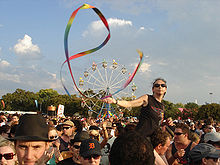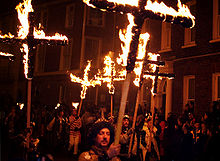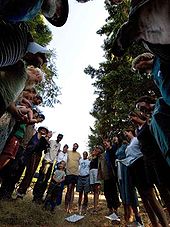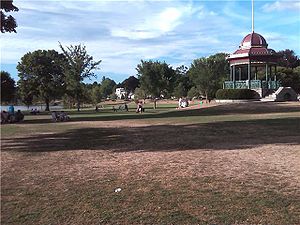
Community
Background to the schools Wikipedia
SOS believes education gives a better chance in life to children in the developing world too. Click here to find out about child sponsorship.
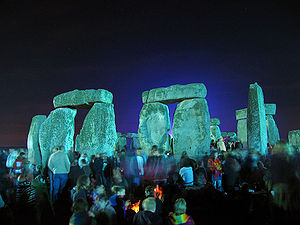
The term community has two distinct commutative meanings: 1) Community can refer to a usually small, social unit of any size that shares common values. The term can also refer to the national community or international community, and 2) in biology, a community is a group of interacting living organisms sharing a populated environment.
In human communities, intent, belief, resources, preferences, needs, risks, and a number of other conditions may be present and common, affecting the identity of the participants and their degree of cohesiveness.
Since the advent of the Internet, the concept of community has less geographical limitation, as people can now gather virtually in an online community and share common interests regardless of physical location. Prior to the internet, virtual communities (like social or academic organizations) were far more limited by the constraints of available communication and transportation technologies.
The word "community" is derived from the Old French communité which is derived from the Latin communitas (cum, "with/together" + munus, "gift"), a broad term for fellowship or organized society. Some examples of community service are to help in church, tutoring, hospitals, etc.
Perspectives from various disciplines
Sociology
| Sociology |
|---|
 Social Network Analysis diagram
|
| Outline |
|
|
| Research methods |
|
|
|
| See also |
|
Gemeinschaft and Gesellschaft
German sociologist Ferdinand Tönnies distinguished between two types of human association: Gemeinschaft (usually translated as "community") and Gesellschaft ("society" or "association"). In his 1887 work, Gemeinschaft und Gesellschaft, Tönnies argued that Gemeinschaft is perceived to be a tighter and more cohesive social entity, due to the presence of a "unity of will." He added that family and kinship were the perfect expressions of Gemeinschaft, but that other shared characteristics, such as place or belief, could also result in Gemeinschaft. This paradigm of communal networks and shared social understanding has been applied to multiple cultures in many places throughout history. Gesellschaft, on the other hand, is a group in which the individuals who make up that group are motivated to take part in the group purely by self-interest. He also proposed that in the real world, no group was either pure Gemeinschaft or pure Gesellschaft, but, rather, a mixture of the two.
Social capital
If community exists, both freedom and security may exist as well. The community then takes on a life of its own, as people become free enough to share and secure enough to get along. The sense of connectedness and formation of social networks comprise what has become known as social capital.
Social capital is defined by Robert D. Putnam as "the collective value of all social networks and species (who people know) and the inclinations that arise from these works to do things for each other (norms of reciprocity)." Social capital in action can be seen in all sorts of groups, including neighbors keeping an eye on each other's homes. However, as Putnam notes in Bowling Alone: The Collapse and Revival of American Community (2000), social capital has been falling in the United States. Putnam found that over the past 25 years, attendance at club meetings has fallen 58 percent, family dinners are down 33 percent, and having friends visit has fallen 45 percent.
The same patterns are also evident in many other western countries. Western cultures are thus said to be losing the spirit of community that once were found in institutions including churches and community centers. Sociologist Ray Oldenburg states in The Great Good Place that people need three places: 1) the home, 2) the office, and, 3) the community hangout or gathering place. With this philosophy in mind, many grassroots efforts such as The Project for Public Spaces are being started to create this " Third Place" in communities. They are taking form in independent bookstores, coffeehouses, local pubs, and through new and innovative means to create the social capital needed to foster the sense and spirit of community.
Psychology
Community
In a seminal 1986 study, McMillan and Chavis identify four elements of "sense of community": 1) membership, 2) influence, 3) integration and fulfillment of needs, and 4) shared emotional connection. They give the following example of the interplay between these factors:
Someone puts an announcement on the dormitory bulletin board about the formation of an intramural dormitory basketball team. People attend the organizational meeting as strangers out of their individual needs (integration and fulfillment of needs). The team is bound by place of residence (membership boundaries are set) and spends time together in practice (the contact hypothesis). They play a game and win (successful shared valent event). While playing, members exert energy on behalf of the team (personal investment in the group). As the team continues to win, team members become recognized and congratulated (gaining honour and status for being members), Influencing new members to join and continue to do the same. Someone suggests that they all buy matching shirts and shoes (common symbols) and they do so (influence).
A Sense of Community Index (SCI) has been developed by Chavis and colleagues and revised and adapted by others. Although originally designed to assess sense of community in neighborhoods, the index has been adapted for use in schools, the workplace, and a variety of types of communities.
Studies conducted by the APPA show substantial evidence that young adults who feel a sense of belonging in a community, particularly small communities, develop fewer psychiatric and depressive disorders than those who do not have the feeling of love and belonging.
Anthropology
Cultural (or social) anthropology has traditionally looked at community through the lens of ethnographic fieldwork and ethnography continues to be an important methodology for study of modern communities. Other anthropological approaches that deal with various aspects of community include cross-cultural studies and the anthropology of religion. Cultures in modern society are also studied in the fields of urban anthropology, ethnic studies, ecological anthropology, and psychological anthropology. Since the 1990s, internet communities have increasingly been the subject of research in the emerging field of cyber anthropology.
Archaeology
Archaeological studies of social communities. The term "community" is used in two ways in archaeology, paralleling usage in other areas. The first is an informal definition of community as a place where people used to live. In this sense it is synonymous with the concept of an ancient settlement, whether a hamlet, village, town, or city. The second meaning is similar to the usage of the term in other social sciences: a community is a group of people living near one another who interact socially. Social interaction on a small scale can be difficult to identify with archaeological data. Most reconstructions of social communities by archaeologists rely on the principle that social interaction is conditioned by physical distance. Therefore a small village settlement likely constituted a social community, and spatial subdivisions of cities and other large settlements may have formed communities. Archaeologists typically use similarities in material culture—from house types to styles of pottery—to reconstruct communities in the past. This is based on the assumption that people or households will share more similarities in the types and styles of their material goods with other members of a social community than they will with outsiders.
Business and communications
Organizational communication
Effective communication practices in group and organizational settings are very important to the formation and maintenance of communities. The ways that ideas and values are communicated within communities are important to the induction of new members, the formulation of agendas, the selection of leaders and many other aspects. Organizational communication is the study of how people communicate within an organizational context and the influences and interactions within organizational structures. Group members depend on the flow of communication to establish their own identity within these structures and learn to function in the group setting. Although organizational communication, as a field of study, is usually geared toward companies and business groups, these may also be seen as communities. The principles of organizational communication can also be applied to other types of communities.
Ecology
In ecology, a community is an assemblage of populations of different species, interacting with one another. Community ecology is the branch of ecology that studies interactions between and among species. It considers how such interactions, along with interactions between species and the abiotic environment, affect community structure and species richness, diversity and patterns of abundance. Species interact in three ways: competition, predation and mutualism. Competition typically results in a double negative—that is both species lose in the interaction. Predation is a win/lose situation with one species winning. Mutualism, on the other hand, involves both species cooperating in some way, with both winning.
Interdisciplinary perspectives
Socialization
The process of learning to adopt the behaviour patterns of the community is called socialization. The most fertile time of socialization is usually the early stages of life, during which individuals develop the skills and knowledge and learn the roles necessary to function within their culture and social environment. For some psychologists, especially those in the psychodynamic tradition, the most important period of socialization is between the ages of one and ten. But socialization also includes adults moving into a significantly different environment, where they must learn a new set of behaviors.
Socialization is influenced primarily by the family, through which children first learn community norms. Other important influences include schools, peer groups, people, mass media, the workplace, and government. The degree to which the norms of a particular society or community are adopted determines one's willingness to engage with others. The norms of tolerance, reciprocity, and trust are important "habits of the heart," as de Tocqueville put it, in an individual's involvement in community.
Community development
Community development, often linked with Community Work or Community Planning, is often formally conducted by non-government organisations (NGOs), universities or government agencies to progress the social well-being of local, regional and, sometimes, national communities. Less formal efforts, called community building or community organizing, seek to empower individuals and groups of people by providing them with the skills they need to effect change in their own communities. These skills often assist in building political power through the formation of large social groups working for a common agenda. Community development practitioners must understand both how to work with individuals and how to affect communities' positions within the context of larger social institutions.
Formal programs conducted by universities are often used to build a knowledge base to drive curricula in sociology and community studies. The General Social Survey from the National Opinion Research Centre at the University of Chicago and the Saguaro Seminar at the John F. Kennedy School of Government at Harvard University are examples of national community development in the United States. In The United Kingdom, Oxford University has led in providing extensive research in the field through its Community Development Journal, used worldwide by sociologists and community development practitioners.
At the intersection between community development and community building are a number of programs and organizations with community development tools. One example of this is the program of the Asset Based Community Development Institute of Northwestern University. The institute makes available downloadable tools to assess community assets and make connections between non-profit groups and other organizations that can help in community building. The Institute focuses on helping communities develop by "mobilizing neighbourhood assets" — building from the inside out rather than the outside in.
Community building and organizing
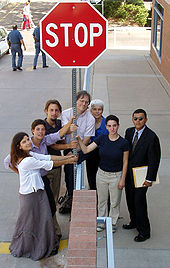
In The Different Drum: Community-Making and Peace, Scott Peck argues that the almost accidental sense of community that exists at times of crisis can be consciously built. Peck believes that conscious community building is a process of deliberate design based on the knowledge and application of certain rules. He states that this process goes through four stages:
- Pseudocommunity: The beginning stage when people first come together. This is the stage where people try to be nice, and present what they feel are their most personable and friendly characteristics.
- Chaos: When people move beyond the inauthenticity of pseudo-community and feel safe enough to present their "shadow" selves. This stage places great demands upon the facilitator for greater leadership and organization, but Peck believes that "organizations are not communities", and this pressure should be resisted.
- Emptiness: This stage moves beyond the attempts to fix, heal and convert of the chaos stage, when all people become capable of acknowledging their own woundedness and brokenness, common to us all as human beings. Out of this emptiness comes
- True community: the process of deep respect and true listening for the needs of the other people in this community. This stage Peck believes can only be described as "glory" and reflects a deep yearning in every human soul for compassionate understanding from one's fellows.
More recently Peck remarked that building a sense of community is easy but maintaining this sense of community is difficult in the modern world. Community building can use a wide variety of practices, ranging from simple events such as potlucks and small book clubs to larger–scale efforts such as mass festivals and construction projects that involve local participants rather than outside contractors.
Community building that is geared toward citizen action is usually termed "community organizing." In these cases, organized community groups seek accountability from elected officials and increased direct representation within decision-making bodies. Where good-faith negotiations fail, these constituency-led organizations seek to pressure the decision-makers through a variety of means, including picketing, boycotting, sit-ins, petitioning, and electoral politics. The ARISE Detroit! coalition and the Toronto Public Space Committee are examples of activist networks committed to shielding local communities from government and corporate domination and inordinate influence.
Community organizing is sometimes focused on more than just resolving specific issues. Organizing often means building a widely accessible power structure, often with the end goal of distributing power equally throughout the community. Community organizers generally seek to build groups that are open and democratic in governance. Such groups facilitate and encourage consensus decision-making with a focus on the general health of the community rather than a specific interest group. The three basic types of community organizing are grassroots organizing, coalition building, and "institution-based community organizing," (also called "broad-based community organizing," an example of which is faith-based community organizing, or Congregation-based Community Organizing).
If communities are developed based on something they share in common, whether that be location or values, then one challenge for developing communities is how to incorporate individuality and differences. Indeed, as Rebekah Nathan suggests in her book, My Freshman Year, we are actually drawn to developing communities totally based on sameness, despite stated commitments to diversity, such as those found on university websites. Nathan states that certain commonalities allow college students to cohere: "What holds students together, really, is age, pop culture, a handful of (recent) historical events, and getting a degree" (qtd. In Barrios 229). Universities may try to create community through all freshman reads, freshman seminars, and school pride; however, Nathan argues students will only form communities based on the attributes, such as age and pop culture, that they bring with them to college. Nathan's point, then, is that people come to college and don't expand their social horizons and cultural tolerance, which can prevent the development of your social community. (Barrios, Barclay. Emerging: Conetmporary Readings for Writers. New York: Bedford St. Martins, 2010.)
Community currencies
Some communities have developed their own " Local Exchange Trading Systems" (LETS) and local currencies, such as the Ithaca Hours system, to encourage economic growth and an enhanced sense of community. Community Currencies have recently proven valuable in meeting the needs of people living in various South American nations, particularly Argentina, that recently suffered as a result of the collapse of the Argentinian national currency.
Community service
Community service is usually performed in connection with a nonprofit organization, but it may also be undertaken under the auspices of government, one or more businesses, or by individuals. It is typically unpaid and voluntary. However, it can be part of alternative sentencing approaches in a justice system and it can be required by educational institutions.
Types of community
A number of ways to categorize types of community have been proposed; one such breakdown is:
- Geographic communities: range from the local neighbourhood, suburb, village, town or city, region, nation or even the planet as a whole. These refer to communities of location.
- Communities of culture: range from the local clique, sub-culture, ethnic group, religious, multicultural or pluralistic civilisation, or the global community cultures of today. They may be included as communities of need or identity, such as disabled persons, or frail aged people.
- Community organizations: range from informal family or kinship networks, to more formal incorporated associations, political decision making structures, economic enterprises, or professional associations at a small, national or international scale.
Communities are nested; one community can contain another—for example a geographic community may contain a number of ethnic communities.
Location
Possibly the most common usage of the word "community" indicates a large group living in close proximity. Examples of local community include:
- A municipality is an administrative local area generally composed of a clearly defined territory and commonly referring to a town or village.
Although large cities are also municipalities, they are often thought of as a collection of communities, due to their diversity.
- A neighbourhood is a geographically localized community, often within a larger city or suburb.
- A planned community is one that was designed from scratch and grew up more or less following the plan. Several of the world's capital cities are planned cities, notably Washington, D.C., in the United States, Canberra in Australia, and Brasília in Brazil. It was also common during the European colonization of the Americas to build according to a plan either on fresh ground or on the ruins of earlier Amerindian cities.
Identity
In some contexts, "community" indicates a group of people with a common identity other than location. Members often interact regularly. Common examples in everyday usage include:
- A "professional community" is a group of people with the same or related occupations. Some of those members may join a professional society, making a more defined and formalized group. These are also sometimes known as communities of practice.
- A virtual community is a group of people primarily or initially communicating or interacting with each other by means of information technologies, typically over the Internet, rather than in person. These may be either communities of interest, practice or communion. Research interest is evolving in the motivations for contributing to online communities.
Overlaps
Some communities share both location and other attributes. Members choose to live near each other because of one or more common interests.
- A retirement community is designated and at least usually designed for retirees and seniors—often restricted to those over a certain age, such as 56. It differs from a retirement home, which is a single building or small complex, by having a number of autonomous households.
- An intentional community is a deliberate residential community with a much higher degree of social communication than other communities. The members of an intentional community typically hold a common social, political or spiritual vision and share responsibilities and resources. Intentional communities include Amish villages, ashrams, cohousing, communes, ecovillages, housing cooperatives, kibbutzim, and land trusts.
Special nature of human community
Definitions of community as "organisms inhabiting a common environment and interacting with one another," while scientifically accurate, do not convey the richness, diversity and complexity of human communities. Their classification, likewise is almost never precise. Untidy as it may be, community is vital for humans. M. Scott Peck expresses this in the following way: "There can be no vulnerability without risk; there can be no community without vulnerability; there can be no peace, and ultimately no life, without community."
